Top 10 Paris Attractions: Eiffel Tower, Louvre, Notre-Dame & Must-See Landmarks
Advertisements
What are the top 10 Paris attractions you can't miss? Explore must-see landmarks like the Eiffel Tower, Louvre, and Notre-Dame in this ultimate guide to Paris' iconic sights, hidden gems, and best cultural experiences for every traveler.
Table of Contents
- Top 10 Paris Attractions
- 1. Eiffel Tower (Tour Eiffel)
- 2. Louvre Museum (Musée du Louvre)
- 3. Notre-Dame Cathedral (Cathédrale Notre-Dame de Paris)
- 4. Arc de Triomphe (Arc de Triomphe de l'Étoile)
- 5. Champs-Élysées (Avenue des Champs-Élysées)
- 6. Musée d'Orsay (Orsay Museum)
- 7. Palace of Versailles (Château de Versailles)
- 8. Sacré-Cœur Basilica (Basilique du Sacré-Cœur)
- 9. Centre Pompidou (Centre Georges Pompidou)
- 10. Luxembourg Gardens (Jardin du Luxembourg)
- Q&A
Paris, the City of Light, is a treasure trove of history, culture, and romance. As a local resident, I've had the privilege of exploring every nook and cranny of this magnificent city. In this comprehensive guide, I'll share with you the top 10 Paris attractions, offering insights into their historical backgrounds, cultural significance, natural and human-made landscapes, operating hours, ticket prices, transportation routes, best times to visit, special events, accommodation recommendations, local culinary delights, and essential tips for a memorable experience.
Top 10 Paris Attractions
1. Eiffel Tower (Tour Eiffel)
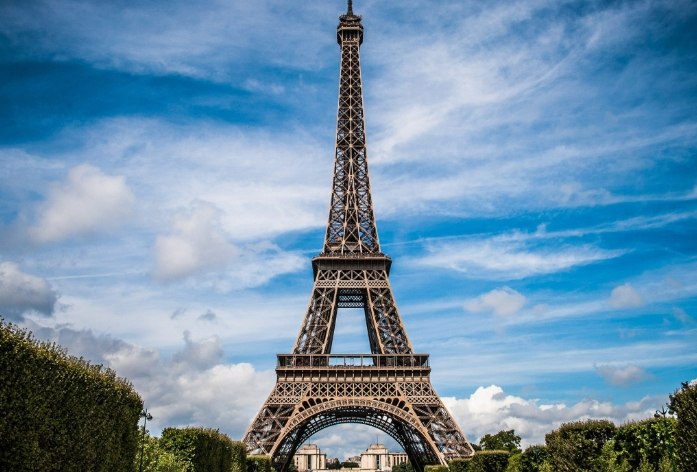
Historical Background
The Eiffel Tower, an iconic symbol of Paris, was built for the 1889 Exposition Universelle (World's Fair) to commemorate the 100th anniversary of the French Revolution. Designed by Gustave Eiffel, it was initially met with controversy but has since become one of the most recognized structures in the world.
Cultural Significance
The tower represents the engineering prowess of the late 19th century and has become a global icon of Paris. It's featured in countless films, artworks, and literature, embodying the spirit of the city.
Natural and Human-Made Landscapes
Standing at 324 meters tall, the Eiffel Tower offers breathtaking panoramic views of Paris. The surrounding Champ de Mars, a large public green space, provides a peaceful retreat amidst the urban hustle.
Operating Hours
The tower is open daily from 9:30 AM to 11:45 PM, with extended hours during the summer months.
Ticket Prices
Prices vary depending on the level you wish to visit. The second floor costs €16.70 for adults, while the summit is €26.10. There are discounts for children and seniors.
Transportation Routes
The closest métro stations are Bir-Hakeim (line 6) and Trocadéro (lines 6 and 9). The RER C train also stops at Champ de Mars - Tour Eiffel.
Best Time to Visit
Early morning or late evening are ideal to avoid crowds and enjoy the tower lit up at night.
Special Events
The tower hosts various events throughout the year, including New Year's Eve fireworks and seasonal light displays.
Accommodation Recommendations
- Hôtel Eiffel Blomet: A charming boutique hotel near the tower.
- Pullman Paris Tour Eiffel: Offers stunning views of the Eiffel Tower from its rooms.
Local Culinary Delights
- Le Jules Verne: A Michelin-starred restaurant on the second floor of the tower.
- Crêperie Bretonne: Nearby crêpe stand for a quick, delicious snack.
Essential Tips
- Book tickets in advance to skip the long lines.
- Be prepared for security checks.
2. Louvre Museum (Musée du Louvre)
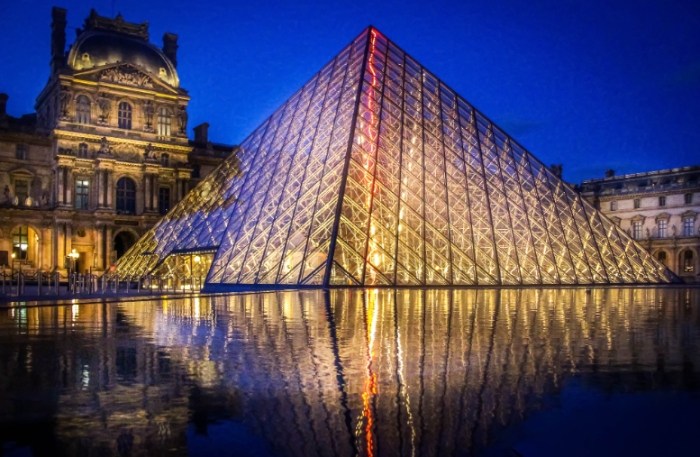
Historical Background
The Louvre, once a royal palace, is now the world's largest art museum. It houses over 38,000 objects from prehistory to the 21st century, showcasing the evolution of human creativity.
Cultural Significance
The museum is a cultural beacon, attracting millions of visitors annually. It's home to iconic works like the Mona Lisa and the Venus de Milo.
Natural and Human-Made Landscapes
The Louvre's glass pyramid, designed by I.M. Pei, is a modern architectural marvel contrasting with the historic palace. The surrounding Tuileries Gardens offer a serene escape.
Operating Hours
Open daily from 9 AM to 6 PM, except on Tuesdays. Extended hours on Wednesdays and Fridays until 9:45 PM.
Ticket Prices
€17 for adults, with free entry for under-18s and EU residents under 26.
Transportation Routes
Métro stations Palais Royal - Musée du Louvre (line 1 and 7) and Pyramides (line 14) are closest.
Best Time to Visit
Weekdays during off-peak hours to avoid crowds.
Special Events
The museum hosts temporary exhibitions and cultural events throughout the year.
Accommodation Recommendations
- Hôtel de Crillon: A luxury hotel near the Place de la Concorde.
- Hôtel Brighton: Offers views of the Tuileries Gardens.
Local Culinary Delights
- Café Marly: Located inside the Louvre, offering a chic dining experience.
- Angelina: Famous for its hot chocolate and pastries, just a short walk away.
Essential Tips
- Download the Louvre app for a self-guided tour.
- Wear comfortable shoes as the museum is vast.
3. Notre-Dame Cathedral (Cathédrale Notre-Dame de Paris)
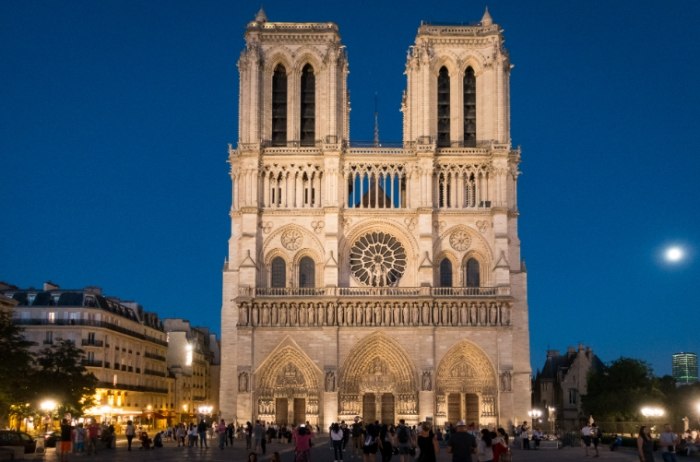
Historical Background
Notre-Dame, a masterpiece of Gothic architecture, was built between 1163 and 1345. It survived the French Revolution and was the site of many significant historical events, including Napoleon's coronation.
Cultural Significance
The cathedral is a symbol of Paris and a UNESCO World Heritage Site. It's featured in Victor Hugo's "The Hunchback of Notre-Dame," adding to its cultural allure.
Natural and Human-Made Landscapes
The Île de la Cité, where Notre-Dame stands, is the historical heart of Paris. The Seine River flows nearby, offering picturesque views.
Operating Hours
Currently closed for restoration after the 2019 fire, but the exterior is accessible.
Ticket Prices
Free for the exterior; interior access is pending restoration completion.
Transportation Routes
Métro stations Cité (line 4) and Saint-Michel - Notre-Dame (lines 4 and RER B and C) are nearby.
Best Time to Visit
Early morning or late afternoon for fewer crowds and better lighting for photos.
Special Events
The cathedral traditionally hosts Christmas and Easter services, though these are currently affected by the restoration.
Accommodation Recommendations
- Hôtel Le Notre Dame: Located steps away from the cathedral.
- Hôtel des Deux Îles: Offers a charming stay on the Île Saint-Louis.
Local Culinary Delights
- Berthillon: Renowned ice cream parlor on the Île Saint-Louis.
- Le Procope: Paris's oldest café, serving classic French dishes.
Essential Tips
- Check the latest updates on restoration progress before planning a visit.
- Respect the ongoing work and any restrictions in place.
4. Arc de Triomphe (Arc de Triomphe de l'Étoile)
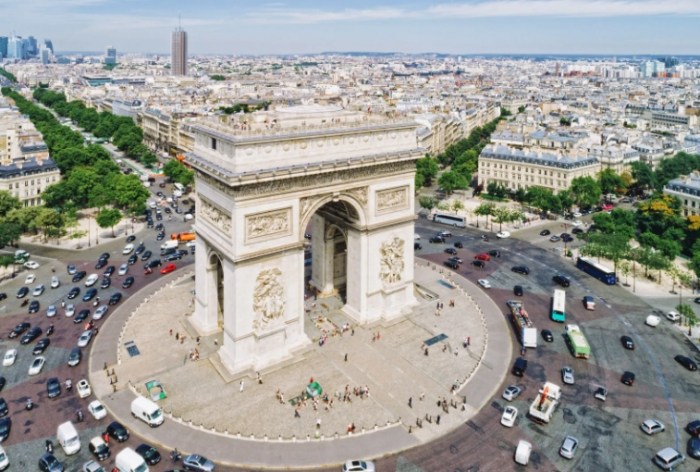
Historical Background
The Arc de Triomphe, commissioned by Napoleon in 1806, honors those who fought and died for France in the French Revolutionary and Napoleonic Wars.
Cultural Significance
It's a national monument and a symbol of French patriotism. The Tomb of the Unknown Soldier lies beneath, with an eternal flame lit since 1923.
Natural and Human-Made Landscapes
Standing at the western end of the Champs-Élysées, the arch offers views of the Avenue des Champs-Élysées and the Place de l'Étoile.
Operating Hours
Open daily from 10 AM to 10:30 PM, with extended hours in summer.
Ticket Prices
€13 for adults, with discounts for children and seniors.
Transportation Routes
Métro station Charles de Gaulle - Étoile (lines 1, 2, and 6) is directly beneath the arch.
Best Time to Visit
Sunset or at night for stunning views of Paris lit up.
Special Events
The arch hosts military parades on Bastille Day (July 14th).
Accommodation Recommendations
- Hôtel Raphael: A luxury hotel near the Arc de Triomphe.
- Hôtel Balmoral: Offers views of the arch from some rooms.
Local Culinary Delights
- Fouquet's: A historic brasserie on the Champs-Élysées.
- Ladurée: Famous for its macarons, located nearby.
Essential Tips
- Use the underground tunnel to cross the busy roundabout to reach the arch.
- Be prepared for security checks.
5. Champs-Élysées (Avenue des Champs-Élysées)
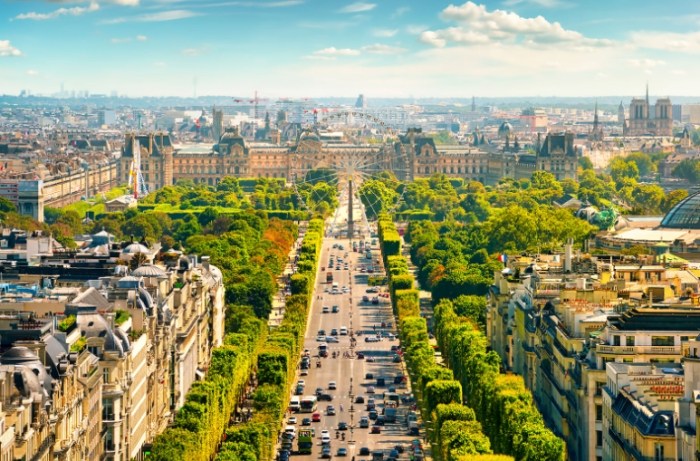
Historical Background
The Champs-Élysées, one of the most famous avenues in the world, was originally a path leading to the royal hunting grounds. It was transformed into a grand avenue in the 17th century.
Cultural Significance
It's a symbol of Parisian elegance and a hub for fashion, entertainment, and culture. The avenue hosts the annual Bastille Day military parade and the finish of the Tour de France.
Natural and Human-Made Landscapes
The avenue is lined with trees, shops, cafés, and theaters. The Place de la Concorde and the Arc de Triomphe frame its ends.
Operating Hours
Shops and cafés typically open from 10 AM to 8 PM, with later hours on weekends.
Ticket Prices
Free to walk along; entry to shops and attractions varies.
Transportation Routes
Métro stations Charles de Gaulle - Étoile (lines 1, 2, and 6) and Concorde (lines 1, 8, and 12) are closest.
Best Time to Visit
During the day for shopping and sightseeing, or at night for a romantic stroll.
Special Events
The avenue is decorated for Christmas and hosts various festivals throughout the year.
Accommodation Recommendations
- Hôtel Barrière Le Fouquet's: Located on the Champs-Élysées.
- Hôtel de Crillon: A short walk away, offering luxury and elegance.
Local Culinary Delights
- L'Atelier de Joël Robuchon: A Michelin-starred restaurant nearby.
- Café de la Paix: A historic café with a view of the Place de l'Opéra.
Essential Tips
- Be prepared for crowds, especially during peak tourist seasons.
- Watch out for pickpockets in busy areas.
6. Musée d'Orsay (Orsay Museum)
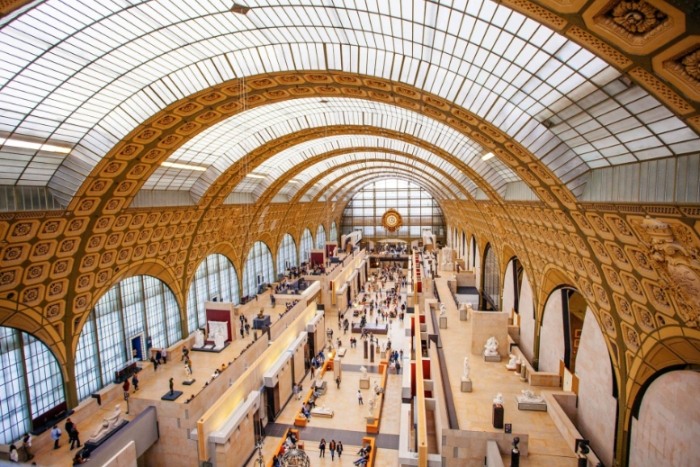
Historical Background
The Musée d'Orsay, housed in a former railway station built for the 1900 Exposition Universelle, opened as a museum in 1986. It focuses on art from 1848 to 1914.
Cultural Significance
The museum is renowned for its Impressionist and Post-Impressionist collections, including works by Monet, Van Gogh, and Renoir.
Natural and Human-Made Landscapes
The station's grand architecture, with its clock tower and glass roof, provides a unique backdrop for the art. The Seine River is visible from the museum's upper floors.
Operating Hours
Open daily from 9:30 AM to 6 PM, except on Mondays. Extended hours on Thursdays until 9:45 PM.
Ticket Prices
€16 for adults, with discounts for children and seniors.
Transportation Routes
Métro stations Solférino (line 12) and Assemblée Nationale (line 12) are nearby.
Best Time to Visit
Weekdays during off-peak hours to avoid crowds.
Special Events
The museum hosts temporary exhibitions and cultural events throughout the year.
Accommodation Recommendations
- Hôtel Lutetia: A luxury hotel near the museum.
- Hôtel de Varenne: Offers a quiet stay in the 7th arrondissement.
Local Culinary Delights
- Le Grand Véfour: A historic restaurant near the Palais-Royal.
- Café Constant: A cozy bistro serving classic French cuisine.
Essential Tips
- Book tickets in advance to skip the lines.
- Consider a guided tour for in-depth insights.
7. Palace of Versailles (Château de Versailles)
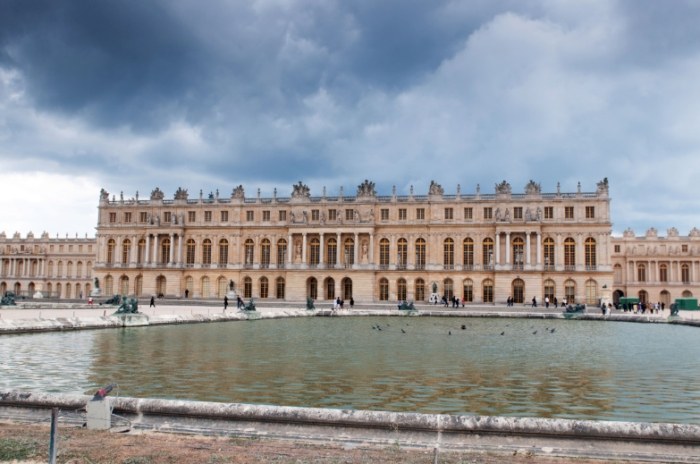
Historical Background
The Palace of Versailles, originally a hunting lodge, was transformed into a grand palace by Louis XIV in the 17th century. It served as the seat of French royalty until the French Revolution.
Cultural Significance
The palace is a symbol of the absolute monarchy and a UNESCO World Heritage Site. Its Hall of Mirrors and Gardens of Versailles are legendary.
Natural and Human-Made Landscapes
The palace's expansive gardens, designed by André Le Nôtre, feature fountains, sculptures, and meticulously landscaped lawns. The Grand Canal offers boating opportunities.
Operating Hours
Open daily from 9 AM to 6:30 PM, with extended hours in summer.
Ticket Prices
€20 for the palace and gardens, with additional fees for special exhibitions.
Transportation Routes
Take the RER C train to Versailles - Château Rive Gauche station.
Best Time to Visit
Spring or fall for mild weather and fewer crowds.
Special Events
The palace hosts musical fountains shows and night fountains displays during summer.
Accommodation Recommendations
- Trianon Palace Versailles, A Waldorf Astoria Hotel: A luxury hotel near the palace.
- Hôtel le Versailles: Offers a comfortable stay in Versailles.
Local Culinary Delights
- Gordon Ramsay au Trianon: A Michelin-starred restaurant at the Trianon Palace.
- La Flottille: A riverside restaurant serving traditional French dishes.
Essential Tips
- Arrive early to avoid long lines.
- Wear comfortable shoes for walking in the gardens.
8. Sacré-Cœur Basilica (Basilique du Sacré-Cœur)
Historical Background
The Sacré-Cœur, built between 1875 and 1914, is a Roman Catholic church dedicated to the Sacred Heart of Jesus. It was constructed as a penance for the excesses of the Second Empire.
Cultural Significance
The basilica is a symbol of Parisian spirituality and a popular pilgrimage site. Its dome offers panoramic views of the city.
Natural and Human-Made Landscapes
Standing atop the Montmartre hill, the basilica overlooks the charming streets of Montmartre and the Paris skyline. The Place du Tertre, with its artists and cafés, is nearby.
Operating Hours
Open daily from 6 AM to 10:30 PM.
Ticket Prices
Free to enter; a small fee for the dome climb.
Transportation Routes
Métro stations Anvers (line 2) and Abbesses (line 12) are closest.
Best Time to Visit
Early morning or late afternoon for fewer crowds and better lighting.
Special Events
The basilica hosts religious services and concerts throughout the year.
Accommodation Recommendations
- Hôtel des Arts Montmartre: A charming hotel in the heart of Montmartre.
- Hôtel Particulier Montmartre: Offers a boutique stay in a historic setting.
Local Culinary Delights
- Le Moulin de la Galette: A historic restaurant in Montmartre.
- La Maison Rose: A famous pink café in the area.
Essential Tips
- Be prepared for stairs if climbing the dome.
- Respect the religious significance of the basilica.
9. Centre Pompidou (Centre Georges Pompidou)
Historical Background
The Centre Pompidou, opened in 1977, is a modern art museum and cultural center. It's named after French President Georges Pompidou, who initiated the project.
Cultural Significance
The museum is renowned for its contemporary art collections, including works by Picasso, Matisse, and Warhol. Its unique architecture, with exposed pipes and ducts, is a landmark in itself.
Natural and Human-Made Landscapes
The museum's rooftop terrace offers views of Paris. The surrounding Place Georges-Pompidou is a lively public space.
Operating Hours
Open daily from 11 AM to 9 PM, except on Tuesdays.
Ticket Prices
€14 for adults, with discounts for children and seniors.
Transportation Routes
Métro stations Rambuteau (line 11) and Hôtel de Ville (lines 1 and 11) are closest.
Best Time to Visit
Weekdays during off-peak hours to avoid crowds.
Special Events
The museum hosts temporary exhibitions, performances, and workshops throughout the year.
Accommodation Recommendations
- Hôtel Le Marais: A boutique hotel near the museum.
- Hôtel de Ville - Le Marais: Offers a central location in the 4th arrondissement.
Local Culinary Delights
- Chez L'Ami Jean: A Basque-inspired restaurant nearby.
- Le Marais Café: A cozy spot for a coffee or light meal.
Essential Tips
- Consider a combined ticket with the Musée National Picasso-Paris.
- Check the museum's website for upcoming events.
10. Luxembourg Gardens (Jardin du Luxembourg)
Historical Background
The Luxembourg Gardens, created in 1612 by Marie de' Medici, are a public park in the 6th arrondissement. They were inspired by the Boboli Gardens in Florence.
Cultural Significance
The gardens are a popular spot for relaxation, picnics, and cultural events. The Luxembourg Palace, home to the French Senate, is located within the gardens.
Natural and Human-Made Landscapes
The gardens feature manicured lawns, flowerbeds, fountains, and sculptures. The Medici Fountain and the Grand Bassin pond are highlights.
Operating Hours
Open daily from 7:30 AM to 8:30 PM, with extended hours in summer.
Ticket Prices
Free to enter.
Transportation Routes
Métro stations Odéon (lines 4 and 10) and Vavin (line 4) are nearby.
Best Time to Visit
Spring or fall for mild weather and blooming flowers.
Special Events
The gardens host concerts, puppet shows, and other cultural events throughout the year.
Accommodation Recommendations
- Hôtel des Saints-Pères: A charming hotel near the gardens.
- Hôtel Luxembourg Parc: Offers views of the gardens from some rooms.
Local Culinary Delights
- L'Ambroisie: A Michelin-starred restaurant nearby.
- Le Comptoir du Relais: A popular bistro in the area.
Essential Tips
- Bring a picnic blanket and enjoy a meal in the gardens.
- Check the event calendar for upcoming activities.
Q&A
1. What is the number 1 tourist attraction in Paris?
The Eiffel Tower is widely regarded as the number 1 tourist attraction in Paris. Its iconic status, breathtaking views, and rich history make it a must-visit for any traveler to the city.
2. What is the one thing not to miss in Paris?
One thing not to miss in Paris is a visit to the Louvre Museum. Home to countless masterpieces, including the Mona Lisa, the Louvre offers a journey through human history and creativity.
3. What to visit in Paris in 3 days?
In 3 days, you can visit the top 10 Paris attractions, including the Eiffel Tower, Louvre Museum, Notre-Dame Cathedral (exterior for now), Arc de Triomphe, Champs-Élysées, Musée d'Orsay, Palace of Versailles, Sacré-Cœur Basilica, Centre Pompidou, and Luxembourg Gardens. Prioritize based on your interests and plan your itinerary accordingly.
4. Is Paris good for 3 days?
Yes, Paris is an excellent destination for a 3-day trip. With its compact size and efficient public transportation, you can easily explore the top 10 Paris attractions and experience the city's unique charm and culture. However, consider extending your stay if you wish to delve deeper into specific neighborhoods or attractions.
In conclusion, Paris is a city that captivates the heart and mind. The top 10 Paris attractions offer a glimpse into its rich history, vibrant culture, and natural beauty. Whether you're a first-time visitor or a seasoned traveler, these attractions are sure to leave a lasting impression.
Advertisements